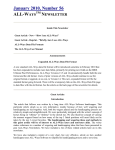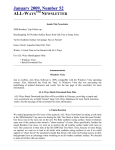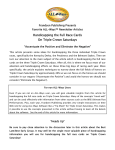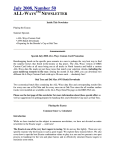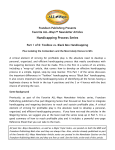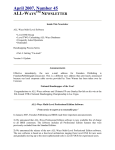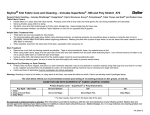Download October 2008, Number 51 ALL-WAYS
Transcript
October 2008, Number 51
ALL-WAYSTM NEWSLETTER
Inside This Newsletter
The 2008 Breeders’ Cup During the Oak Tree Meet at Santa Anita
The Breeders’ Cup for New ALL-Ways Handicappers
ALL-Ways Data File Formats
Announcements
Special Help for Handicapping the 2008 Breeders' Cup
The extensive Breeders' Cup article in this newsletter will help shed some light on the unique
and complex handicapping challenges of this year's Breeders' Cup. The article also explains
how to obtain the special ALL-Ways Handicapping Profiles for this year's Breeders' Cup and
how to economically build a significant ALL-Ways database for the host track.
Expanded ALL-Ways Data File Format
An additional ALL-Ways data file format is being introduced that has been expanded to include
more data fields, primarily for printing new fields on the BRIS Ultimate Past Performances.
ALL-Ways Versions 13.5 and 14 automatically adjust to whichever format you use. Users
of prior versions of ALL-Ways should continue to use the original file format or upgrade, at no
cost, to Version 14. See the article on the last page of this newsletter for details.
The 2008 Breeders’ Cup at Oak Tree/Santa Anita
Major Changes and Challenges
Here we go again! The best trainers, the best jockeys and the best horses in the world are getting
together to compete for the best purses in all of racing. And, they will provide horseplayers with
what typically are the best wager payoffs of the year. The 25th running of the Breeders' Cup
World Championships will be run during the Oak Tree Meet at the Santa Anita race track in
Arcadia, California. This will be the third time the Breeders' Cup has been run at Santa Anita. It
was last run at the track in 2003 and the payoffs were, as usual, very large.
So much for the familiar! There are major changes to the overall format of the Breeders' Cup in
2008. And, for the first time, the Breeders' Cup "dirt" races will be run on a synthetic "all
weather surface" track, adding challenging complexity to the handicapping process. We will start
this article by explaining these changes and challenges. Then, we will present some very helpful
handicapping information specific to the 2008 Breeders' Cup. Through all of this, you will
discover that ALL-Ways Software handicappers will have a significant handicapping advantage
over other players who do not use ALL-Ways. This competitive "edge" may well lead ALLWays handicappers to some of the major wagering payoffs frequently seen on Breeders' Cup
day.
For Non ALL-Ways Handicappers
Even if you are not an ALL-Ways handicapper, this ALL-Ways Newsletter will provide you
with valuable insights into handicapping the 2008 Breeders' Cup races. And, you may want to
give ALL-Ways software a try to prepare for and/or to actually handicap the 2008 BC races.
Please see the last page of this newsletter for easy instructions to get started.
The Major Changes
In 2007, the Breeders' Cup was expanded to a two day event run on Friday and Saturday. The
Friday BC races were all new, specifically the Dirt Mile, the Filly and Mare Sprint and the
Juvenile Turf. The eight primary BC races we have become accustomed to were all run on
Saturday. So, there were a total of eleven races and $23 million in total purse money. At our
local track, we saw the usual big crowd on Saturday, but only a modest crowd for the Friday
races. The major changes in 2008 appear aimed at solving this problem.
In 2008, there will be a total of fourteen BC races run over the two days on Friday, October 24th
and Saturday, October 25th for total purse money of $25.5 million. All the Friday BC races are
for "ladies only". The customary eight BC races will be spread over both race days. See the lists
below of the BC races that will be run each day.
So, the 2008 Breeders' Cup brings us additional races, additional purse money (a record) and two
strong days of BC racing. If you like what we have been calling the eight primary Breeders' Cup
races, you will want to plan on playing both Friday and Saturday.
The 2008 Breeders' Cup at Santa Anita
Friday, October 24th
Filly/Mare Sprint
*Filly/Mare Turf
*Juvenile Fillies
Juvenile Filly Turf
*Ladies Classic
7 furlongs
1 1/4 mile turf
1 1/16 mile
1 mile turf
1 1/6 mile
$1 million
$2 million
$2 million
$1 million
$2 million
Saturday, October 25th
Dirt Mile
*Mile
*Sprint
Juvenile Turf
Marathon
Turf Sprint
*Juvenile
*Turf
*Classic
1 mile
1 mile turf
6 furlongs
1 mile turf
1 1/2 mile
6 1/2 furlongs turf
1 1/6 mile
1 1/2 mile turf
1 1/4 mile
$1 million
$2 million
$2 million
$1 million
$500,000
$1 million
$2 million
$3 million
$5 million
Note: The exact order of races each day had not been announced when this newsletter went to
press.
Breeders’ Cup Chart Notations
- * Denotes the previous eight primary races
- The Ladies Classic was formerly The Distaff
- The Juvenile Filly Turf is new in 2008
- The Turf Sprint is new in 2008
- The Marathon is new in 2008
- The Filly/Mare Sprint was 6 furlongs in 2007
- The Filly/Mare Turf was 1 3/8 mile in 2007
- The Juvenile Turf was 1 mile in 2007
The Major Challenges
Events of the past few years have created two special circumstances related to handicapping the
2008 Breeders' Cup. First and foremost was the installation of the synthetic all weather surface
track at Santa Anita during the fall of 2007. The entire 2007 Oak Tree Meet was run after the
synthetic surface was installed. This means all Breeders' Cup "dirt" races will actually be run on
an all weather surface for the first time in BC history. The second change is that, a few years ago,
the racing industry started maintaining separate data for Santa Anita and the Oak Tree Meet at
Santa Anita, essentially treating Oak Tree as a track. This has made it more difficult to
accumulate handicapping information for the 2008 Breeders' Cup at the same time we need to
handle the challenges of handicapping BC races run on the new synthetic surface. Note: See the
end of this article for how ALL-Ways handicappers can quickly and economically build a
significant ALL-Ways Race Database of races run at Oak Tree since the synthetic surface was
installed.
Withstanding the Test of Time
Before reviewing the Santa Anita track analysis, we are going to re-cap the three
recommendations we make every year regarding handicapping and wagering on Breeders' Cup
races.
1. Pro-actively look for surprises: Many, and often most, of the top four finishers in BC races
are a surprise to the public. You must look beyond class and speed.
2. Do not over-handicap for the winning horse: Spend just a little time looking for the 2 or 3
primary candidates to win the race and invest most of your time identifying reasons why the
favorite may not win and identifying the horses that may do better than the public expects.
3. Be prepared to play larger than usual Exacta, Trifecta and Superfecta Wagers: We think
it is wise to wager on more combinations wagers than you normally would during the rest of the
year. The BC payoffs usually support this.
Santa Anita Track Analysis
The dirt track at Santa Anita is a typical one-mile oval with chutes for 7 furlong sprints and 1 1/4 mile routes. The
Juvenile Filly Turf, the BC Mile and Juvenile Turf will be run entirely on the main turf course.
However, the Filly and Mare Turf (1 1/4 mile), the Turf Sprint (6 1/2 furlongs) and the BC Turf
(1 1/2 mile) will all start on the Hillside Turf Course which has a slightly downhill slope before
crossing over the "dirt" track to join up with the main turf oval for the completion of each race.
The Hillside Turf Course has the only right hand turn at any track in the United States. Foreign
turf horses will probably take well to this unusual track configuration.
As has been our custom the past several years, we are providing some insight into the probable
track influences on the Breeders' Cup races. We used the ALL-Ways Impact Value Analysis,
Top 3 Analysis and Gap Analysis functions to examine our ALL-Ways Race Databases for Santa
Anita. These analyses examine the 87 key handicapping factors in ALL-Ways software that
cover each horse's suitability to the distance and surface, current form, class level and ability to
handle the probable pace and speed demands of the race. We did restrict the analyses to just
high caliber races. As a reminder, an Impact Value (IV) of 1.0 is neutral. An IV of 2.1 means
that horses ranked first for the factor win 2.1 times their fair share of races. An IV below 1.0
means the horses win less than their fair share of races.
All Weather Surface "Dirt" Sprints
This analysis applies to two specific Breeders' Cup races, namely the 7 furlong Filly and Mare
Sprint that will be run on Friday and the 6 furlong BC Sprint that will be run on Saturday.
Again, remember that these races are actually run on the all weather surface. We will spend more
space on the AWS "Dirt" Sprint analysis in order to explain some concepts that will also be used
when we analyze other race types.
Regarding running styles, we start by looking at the AWS "dirt" sprint track bias with respect
to the four basic running styles of "E" (Early), "EP" (Early Presser), "P" (Presser) and "S"
(Sustainer). We are actually going to look at what happens to these bias figures when we go from
all non maiden "real" dirt sprints to only high caliber non maiden "real" dirt sprints to only high
caliber all weather surface "dirt" sprints. This is a bit tricky to follow, but it is a statistical
gem!
Winner Running Style Impact Values
For Both Real and AWS "Dirt" Sprints
"E"
1.65
"EP" "P"
1.34
.99
"S"
.59
Real Dirt
1.29
.83
.78
1.20
AWS "Dirt"
.80
.51
1.26
1.32
All Real Dirt
High Caliber:
When we look at non-maiden dirt sprints run at Santa Anita before the synthetic surface was
installed, we see, what was then, a typical Southern California early speed favoring track with
"E" horses winning 1.65 and "EP" horses winning 1.34 times their fair share of races
respectively. When we limit the analysis to only high caliber "real" dirt races (horses with high
class ratings), we see a shift towards being more kind to closers including "S" horses winning 1.2
times their fair share of races. Now look what happens when we switch the analysis to high
caliber AWS "dirt" sprint races run at Santa Anita on the all weather surface track. We see a
dramatic shift in bias to being very favorable to closers and very unfavorable to early runners.
Regarding post position, our analysis of high caliber AWS "dirt" sprints shows there to be no
significant advantage or disadvantage to where a horse comes out of the gate.
Regarding handicapping factors, we looked for the factors with the best Impact Values for
winning horses. Note that we also show the $2 ROI figure related to the Impact Value. A $2 ROI
figure that is over $2.00 is a profitable situation. For example, a $2 ROI figure of $2.20 means
you would make, on average, 20 cents profit for every $2 wagered. Conversely, a figure below
$2.00 signifies a loss.
Best Handicapping Factors for High Caliber
AWS "Dirt" Sprints at Santa Anita
Factor
IV
BRIS Back Class
1.69
BRIS Back Speed
1.74
Hall Speed Last
1.83
BRIS Final Fraction 2/3 1.86
Hall Late 2/3
2.25
$2 ROI
$1.77
$1.65
$2.44
$2.71
$2.75
Hall Late = Hall Final Fraction + Hall Speed
2/3 = average of best 2 out of the last 3 races
This chart shows that the speed and class factors have reasonable Impact Values, but that it's
difficult to achieve a flat $2 win bet profit using them alone. On the other hand, the BRIS Final
Fraction 2/3 factor and the Hall Late 2/3 factor both reflect the late bias discussed above and
both have good IVs and flat bet profits as is also the case with the Hall Speed Last factor. One
more point to drive home the importance of the late bias for AWS "dirt" sprints: Every
BRIS and Hall handicapping factor for early pace, both at the 1st Call (2 furlong point) and the
2nd Call (4 furlong point) had Impact Values well below 1.0 and lost in the range of $1.50 for
each $2 win wager.
About the Hall Figures: The Hall pace and speed figures have proven to be particularly
effective for handicapping all weather surface races. The Hall figures use the concept of
"conservation of energy" to normalize all past performance pace and speed figures to the exact
distance and surface of today's race, including adapting to the new synthetic surfaces. See ALLways Newsletter #16 for more information.
Some more tidbits: Here are three more handicapping and wagering tidbits we found when
analyzing AWS "dirt" sprints at Santa Anita:
• Excluding early pace, handicapping factors have good Impact Values for each of the three top
ranked horses, which seems to confirm the anecdotal "level playing field" effect of synthetic
surfaces.
• The public over bets top ranked horses for form, class, speed and comprehensive factors and
under bets the 2nd and 3rd ranked horses. For example, the top ranked BRIS Prime Power horse
has an IV of 1.52 but shows a loss of 85 cents for each $2 wagered. However, the 2nd and 3rd
ranked horses have IVs of 1.70 and 1.68 respectively and $2 win bet returns of $2.05 and $2.28
respectively.
• Horses ranked in the rear half of the field for key factors, such as the 5 lowest ranked horses in
a 10 horse field, have horrible Impact Values, about the lowest we have seen. This is helpful for
eliminating false contenders.
All Weather Surface "Dirt" Routes
This analysis applies to the Juvenile Fillies (1 1/16 mile) and the Ladies Classic (1 1/8 mile) that
will be run on Friday and to the Dirt Mile (1 mile), the Juvenile (1 1/16 mile), the Marathon (1
1/2 mile) and the Classic (1 1/4 mile) that will be run on Saturday.
Regarding running styles, we see a slight shift from the early favoring "real" dirt races to a
more even bias on the new synthetic surface, but not nearly as strong a shift as we saw for dirt
sprints.
Winner Running Style Impact Values
For Both Real and AWS "Dirt" Routes
"E"
Real Dirt
1.63
AWS "Dirt" 1.25
"EP" "P"
1.14 1.00
1.04 1.13
"S"
.66
.82
We know, in very high caliber AWS "dirt" sprints, there is a lot of early pace pressure, more than
most of the front runners have ever experienced. This causes the early speed to collapse, setting
the race up for closers. In AWS "dirt" routes, there is not as much early pace pressure, so more
early runners can hang on to the finish.
Regarding post position, there is no significant bias from posts 1 through 10, but horses in the
far outside posts tend not to do well.
Regarding handicapping factors, we see a much better correlation of profitable $2 ROI
performance for the top ranked horse of numerous factors.
Best Handicapping Factors for High Caliber
AWS "Dirt" Routes at Santa Anita
Factor
BRIS Back Class
Hall Speed 2/3
Hall Final Fraction P/L
Hall Late P/L
BRIS Prime Power
IV
$2 ROI
1.75
1.73
1.86
1.92
1.64
$2.50
$2.41
$2.57
$2.63
$1.57
Hall Late = Hall Final Fraction + Hall Speed
2/3 = average of best 2 out of the last 3 races
P/L = figure for the horse's pace line race
Once again we see that horses that close well can lead us to profits. We also see, in order to make
a profit, you must look beyond the obvious all round top horse the Prime Power rating shows us.
Also, when we look at the Impact Values for top ranked horses for BRIS Early Pace (Not shown
above), we see an Impact Value of 2.19 for real dirt routes, but only 1.29 for AWS "dirt" routes.
Turf Sprints
This analysis applies to the 6 1/2 furlong Turf Sprint that will be run on Saturday.
Regarding running styles, we see a slight bias in favor of "E" horses, but "EP" and "P" horses
do well too.
Winner Running Style Impact Values
for High Caliber Turf Sprints
Turf Sprints
"E"
1.43
"EP" "P"
1.06 1.13
"S"
.71
Regarding post position, we see something quite interesting. There is no significant bias from
posts 1 through 10. But, horses in posts 11 and out have a good Impact Value of 1.55 and
yield a whopping $4.53 return on flat $2 win bets. Our theory is that horses in the outside
posts gain an early advantage due to the right turn coming out of the chute. Remember that this is
the only right hand turn at a U.S. track.
Regarding handicapping factors, again we see a much better correlation of profitable $2 ROI
performance for the top ranked horse of numerous factors. The best bets are horses with high
class and good early speed.
Best Handicapping Factors for High Caliber
Turf Sprints at Santa Anita
Factor
Turf Class
Scott PCR
BRIS Speed 2/3
BRIS Early Pace 2/3
BRIS Total 2/3
BRIS Prime Power
IV
$2 ROI
2.10
2.13
1.88
1.85
2.40
2.27
$3.07
$2.94
$1.76
$2.90
$2.37
$2.36
PCR = Scott Performance Class Rating
2/3 = average of best 2 out of the last 3 races
Total = BRIS Early Pace + BRIS Speed
Turf Routes
This analysis applies to the Filly and Mare Turf (1 ¼ mile) and Juvenile Turf (1 mile) that will be
run on Friday and the BC Mile (1 mile), the Juvenile Turf (1 mile) and the BC Turf (1 ½ mile)
that will be run on Saturday.
"Consistency" is the key word here. The running style bias was quite even with a slight
disadvantage for "S" horses. The bias was consistent for all race distances. There is virtually no
post position bias for any of the turf race distances. Regarding handicapping factors, there is
remarkable consistency with what we reported in 2003, the last time the Breeders' Cup was run
at Santa Anita.
Best Handicapping Factors for High Caliber
Turf Routes at Santa Anita
Factor
Turf Class
Scott PCR
BRIS Back Speed
BRIS Late 2/3
ALL-Ways Comp
IV
$2 ROI
2.06
2.27
1.88
1.73
2.39
$1.56
$2.03
$1.80
$1.44
$1.54
PCR = Scott Performance Class Rating
BRIS Late = Final Fraction + Speed
Comp = ALL-Ways Comprehensive
This shows us, once again, that you need to look beyond the obvious to make a profit. Another
observation is that a horse's class and a horse's speed become more important as the length of the
race increases. For example, the Turf Class Impact Value jumps to 3.16 and the $2 ROI jumps to
$2.50 for turf routes of at least 1 ¼ mile. Back Speed figures change to an IV of 2.34 and a $2
ROI of $2.54.
Summary: Finding the surprises
Approximately 65 to 70 percent of all Breeders' Cup races run since 2000 have yielded win
payoffs above $10, Exacta payoffs above $100, Trifecta payoffs above $1,000 and Superfecta
payoffs above $5,000. We expect payoffs to be big in 2008 for two reasons. First, payoffs have
historically been large at prior Breeders' Cups run at Santa Anita, particularly for turf races.
Second is the complexity of handicapping races run on all weather surface tracks. We are now
going to briefly summarize some recommendations for proactively looking for these
opportunities. See ALL-Ways Newsletters #39 and #43 for more info.
Foreign Horses
One reason for big payoffs is the performance of foreign horses that surprise the public,
particularly in the turf races. There are three things to help you in this area. One is to make sure
you are armed with the BRIS TimeForm Ratings. Second, look for foreign horses on Lasix
for the first time. Third, and perhaps most important, look at the BRIS Class Ratings available
for most foreign horses. A 2 point differential in BRIS Class is very significant. If a foreign
horse has been running in lower class races, it will most likely have trouble handling the high
class level of Breeders' Cup races.
Pace Considerations
By far the biggest source of high payoffs on Breeders' Cup day is the high percentage of high
priced closers that finish in the top four. And, all weather surface "dirt" races will only
strengthen this. Fast paced races with ALL-Ways designated Race Pace Shapes of "EEE" and
"EE" are obvious candidates for high priced closers. But, even "Honest Pace" races are run with
somewhat fast early speed due simply to the high caliber of the horses that are competing. Most
of the horses running are the very best in the world. But, they are facing the toughest competition
they have ever faced and often have trouble finishing the race in the strong fashion they usually
do. Another important pace consideration is the specific distance of the race. Longer sprint and
longer routes will give late runners more opportunity to catch the front runners and, conversely,
make it tougher for early speed horses to hold on down the stretch. Remember that one furlong is
one eighth of a mile which is 660 feet, more than two football fields.
So, our recommendations for finding the high priced horses is to be sure and handicap the
foreign horses, require some evidence that early running horses ("E" and "EP") can perform well
in these demanding races and proactively look for surprise closers ("P" and "S") that can do well
down the stretch run.
Special Help from ALL-Ways
ALL-Ways software includes extensive all weather surface handicapping information. We
recommend using the Suitability handicapping report which automatically prints/displays
extensive all weather surface information for the AWS "dirt" races and extensive turf
information for the turf races. We recommend using the Top 10/Ranking handicapping report. It
displays horses in rank order for nineteen different handicapping factors of your choosing,
including all weather surface factors. This is a great way to spot the gaps that separate the
contenders from the pretenders. We also recommend using the ALL-Ways Search handicapping
report, paying particular attention to the Key Horse Candidate list, the Best Early list and the
Best Late list. At last year's Breeders' Cup Saturday at Monmouth, 28 of the 32 horses that
finished in the top 4 positions were identified in these lists and two of the missing horses were
foreign. You will often see the same horse in more than one list. Pay attention!
Finally, if you do not have an ALL-Ways Race Database for the Oak Tree Meet, there are two
ways to go. One is that you can economically build such a database by purchasing the AWS
Batch Download file and the Meet Subscription Package for Oak Tree on the ALL-Ways Data
File page. Or, you can download and use the free Oak Tree Handicapping Profiles posted in the
User's Corner of the Frandsen Publishing Web site.
The 2008 Breeders’ Cup for New ALL-Ways Handicappers
Even if you are not a current ALL-Ways user, you may want to try the software specifically for
the Breeders' Cup. It will give you better insight for finding the big payoffs. Using ALL-Ways
the first time on Breeders' Cup races is relatively easy. Here is how: 1. Download and install the
FREE ALL-Ways software from the BRIS Web site and print the 2 page Quick Start Guide; 2.
Do the practice handicapping session described in the Quick Start Guide. It will only take a few
minutes; 3. Download the FREE special Oak Tree Breeders' Cup Handicapping Profiles from the
Frandsen Publishing Web site; 4. For the Breeders' Cup itself, simply download the ALL-Ways
data file from BRIS and repeat what you did in Step #2 above.
We suggest you use the Pace Line Handicapping Report, the Search Handicapping Report and
the Top 10/Ranking Report. Appendix "C" in the ALL-Ways User Manual explains all
handicapping reports. Appendix B explains every handicapping factor. This will arm you with
everything you need to handicap the Breeders' Cup using the information presented in this
newsletter. Remember, the ALL-Ways data file will also let you print the BRIS Ultimate
Past Performances at no additional cost using the free BRIS PP Generator software.
The ALL-Ways User Manual
ALL-Ways software comes with a comprehensive User's Manual designed as a reference guide
as opposed to being read cover-to-cover. We recommend calling BRIS at 800 354 9206 to order
the User Manual, all printed and in a 3-ring binder. There is a nominal S&H charge. While
waiting for the manual to arrive, we suggest printing and reading Chapter 1 of the full manual
that is available on the ALL-Ways Free Software page.
ALL-Ways Data File Formats
The ALL-Ways data file (Format 1), includes 1,500 fields of data. A new data file (Format 2)
will soon be available that is expanded to 2,500 fields. Only a few of the new fields actually have
new information and the new information, at this time, applies only to printing the BRIS
Ultimate Past Performances. Format 1 has the file extension of ".ALW". Format 2 has a file
extension of ".ALL". ALL-Ways software versions 13.5 and 14 automatically handle both
formats. If you have Version 13.5 or higher, you can access Format 2 by clicking the link on the
ALL-Ways Data File page. If you have an older version of ALL-Ways, you can continue to use
Format 1. Or, you can upgrade to ALL-Ways Version 14 and then use either Format 1 or Format
2. At some point in the future, perhaps in a year, Format 2 will become the only format available
and it will be necessary to use ALL-Ways Version 14 or higher.
ALL-Ways Home Page
© Copyright 2008
Frandsen Publishing Corporation
PO Box 1439
Minnetonka, MN 55345
All Rights Reserved
How to contact Frandsen Publishing
Phone: 952.937.9180
E-Mail: [email protected]
Website: www.frandsen.com
Be sure to check the What’s New page on our Website for
the latest announcements and alerts.











